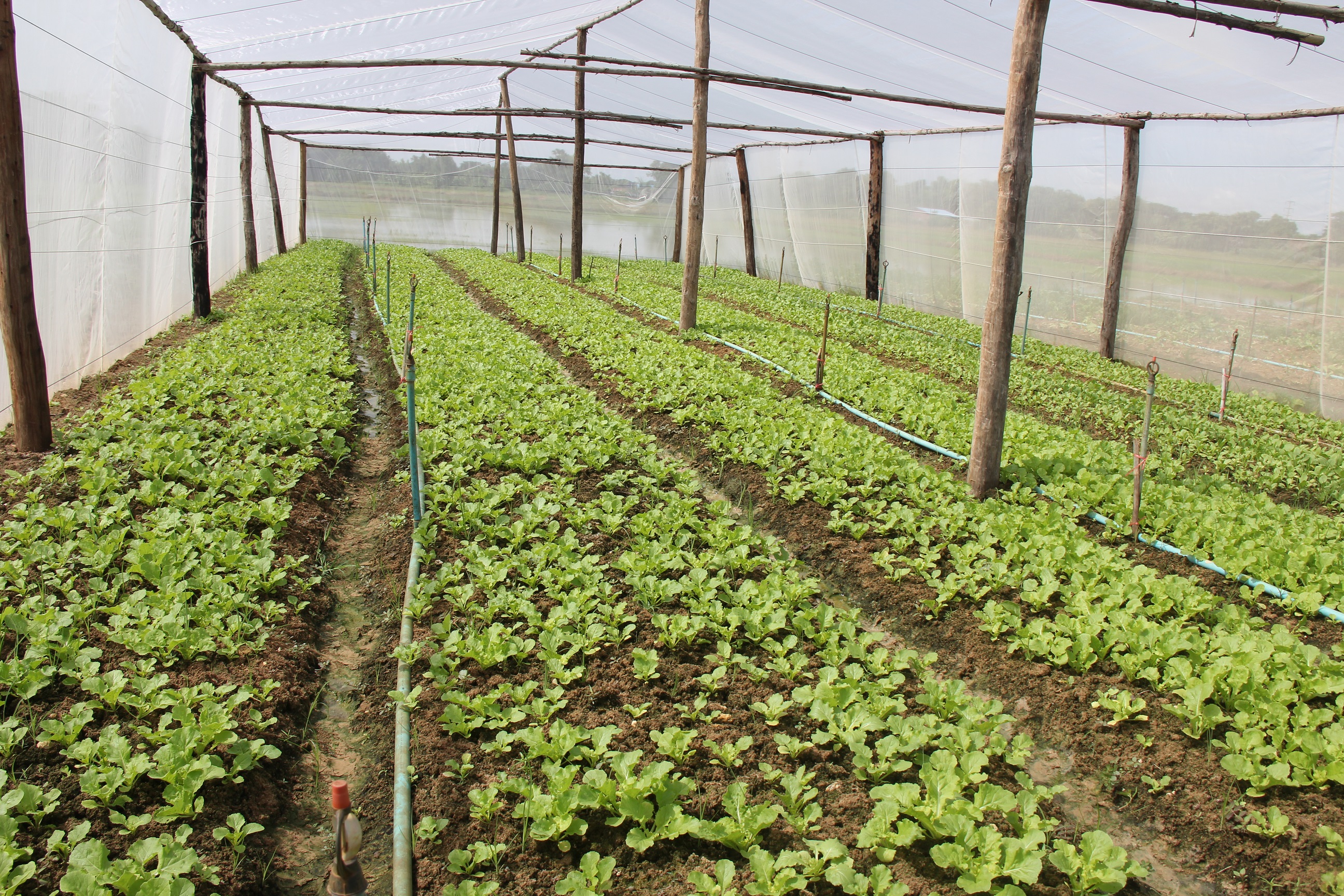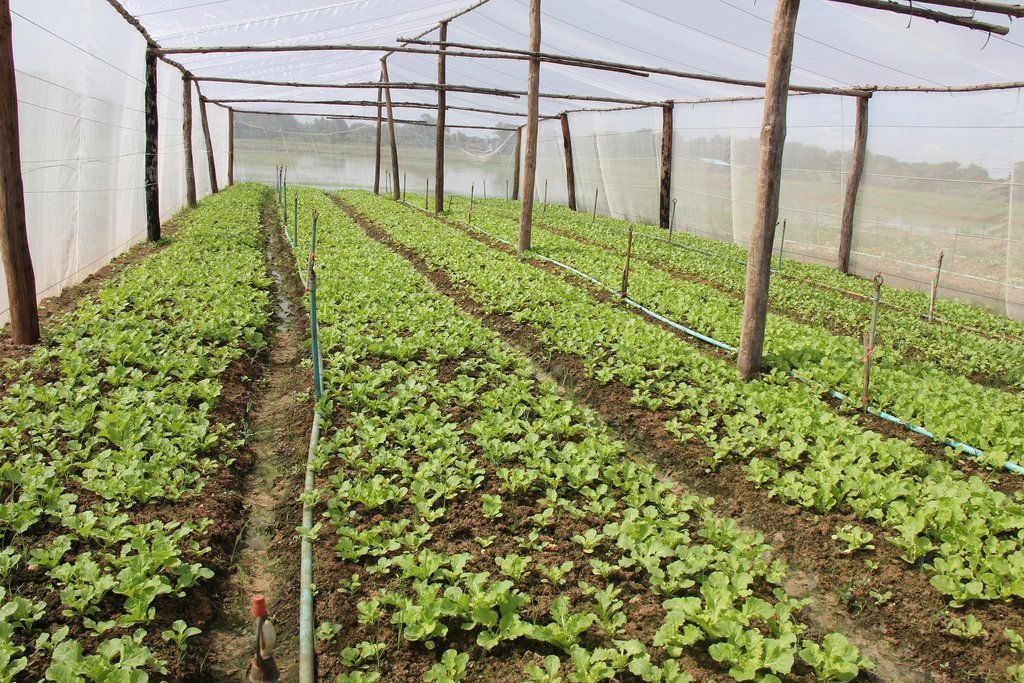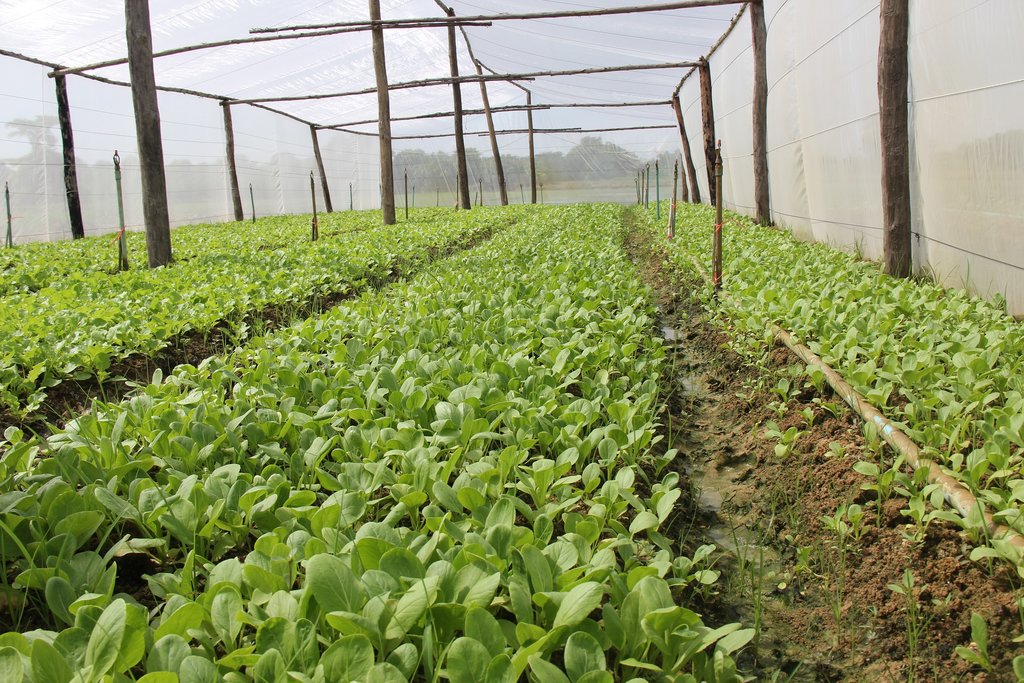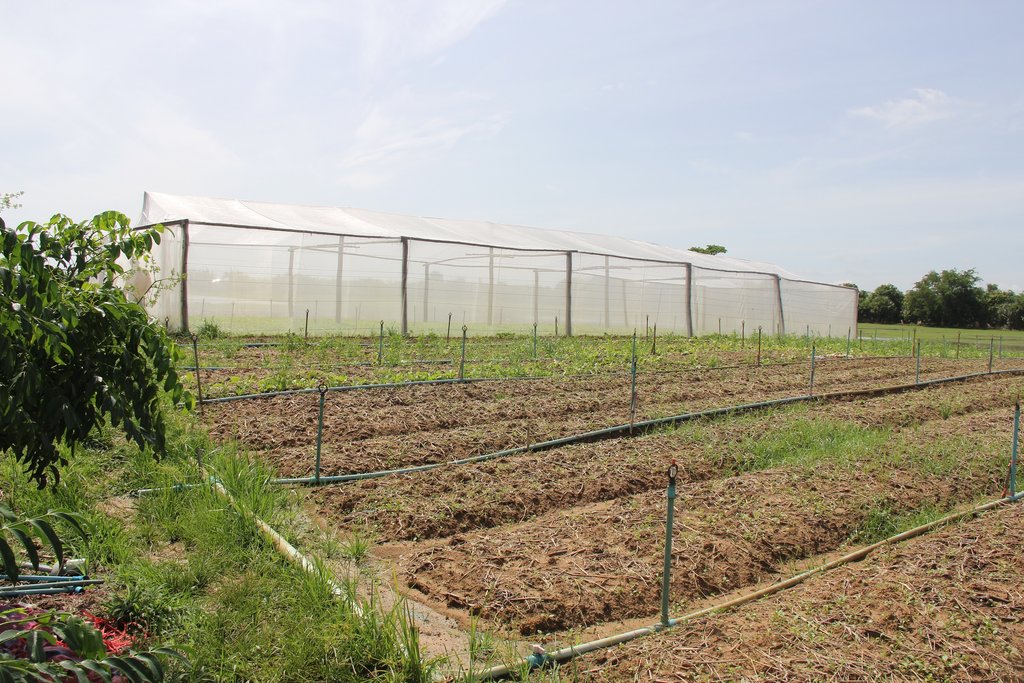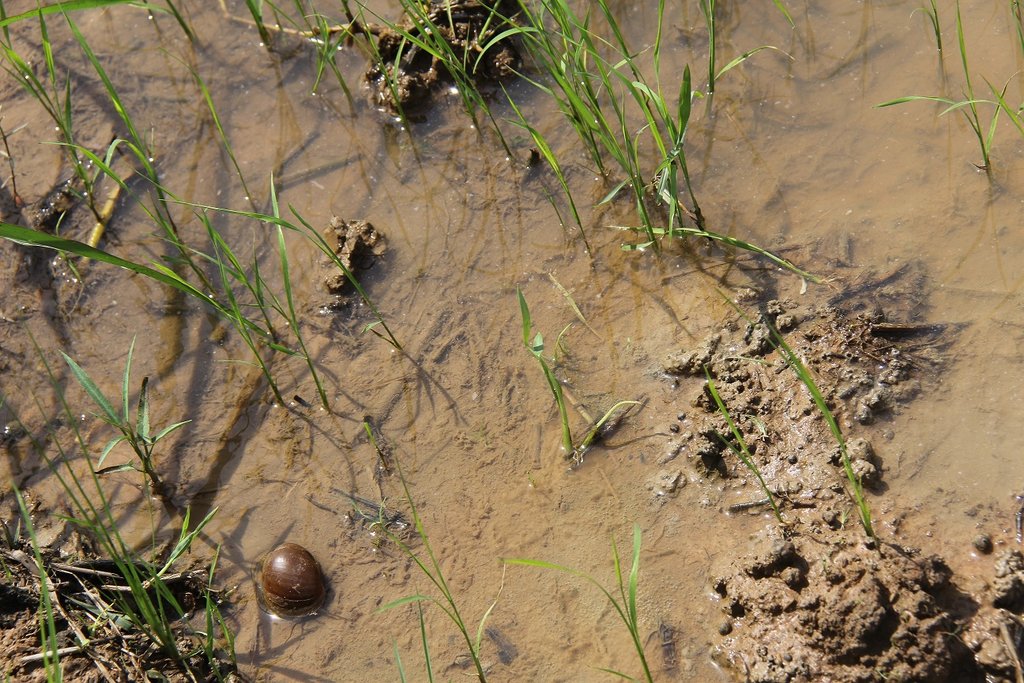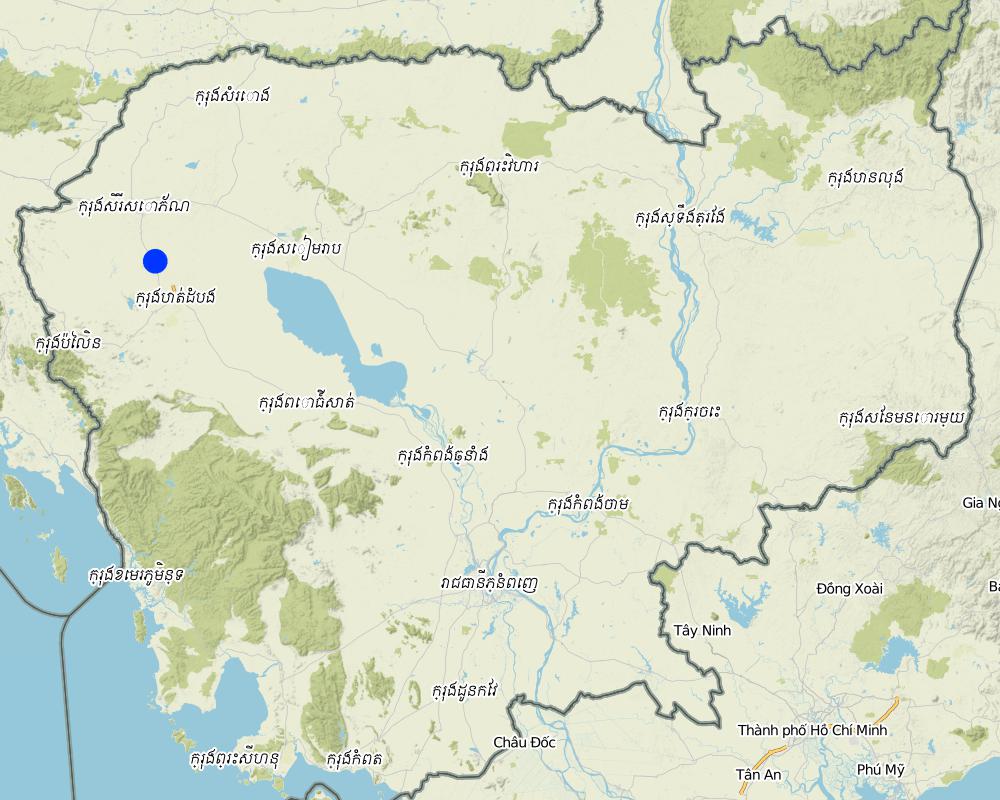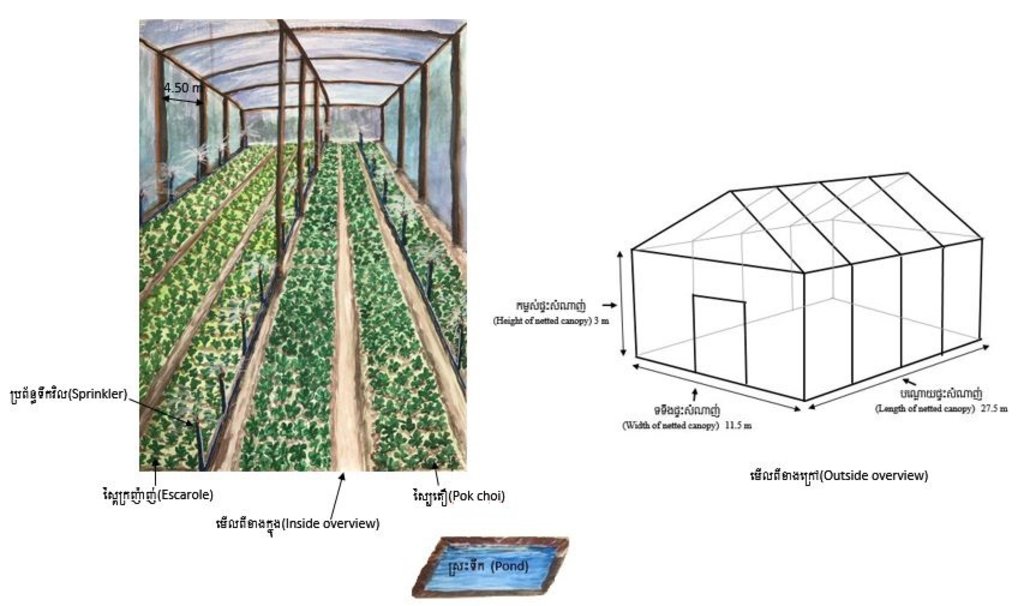ការដាំបន្លែក្នុងផ្ទះសំណាញ់ដើម្បីទប់ទល់នឹងសត្វល្អិតបំផ្លាញ [Cambodia]
- Creation:
- Update:
- Compiler: Nary Lay
- Editors: Navin Chea, Sophea Tim
- Reviewers: Cornelia Hett, Nicole Harari, SO Than, Ursula Gaemperli, Alexandra Gavilano
ផ្ទះសំណាញ់
technologies_3138 - Cambodia
View sections
Expand all Collapse all1. General information
1.2 Contact details of resource persons and institutions involved in the assessment and documentation of the Technology
Key resource person(s)
មន្ត្រីការិយាល័យផ្សព្វផ្សាយកសិកម្មនៅការិយាល័យកសិកម្មស្រុកថ្មគោល:
តារាភូសា ស៊ីវ
ការិយាល័យកសិកម្ម ស្រុកថ្មគោល
Cambodia
ប្រធានការិយាល័យកសិកម្មស្រុកសង្កែ:
មន្ត្រីក្សេត្រសាស្ត្រនៅការិយាល័យកសិកម្ម ស្រុកបវេល:
ឡាម ម៉ូត
ការិយាល័យកសិកម្ម ស្រុកបវេល
Cambodia
land user:
សារុន សេង
កសិករ
Cambodia
បុគ្គលិកក្នុងគម្រោងជំរុញបន្លែសុវត្ថិភាពដើម្បីផលិតបន្លែសុវត្ថិភាពនៅកម្ពុជា:
និន ដាវុធ
ផ្នែកស្រាវជ្រាវ និងផ្សព្វផ្សាយ នៅសាកលវិទ្យាល័យភូមិន្ទកសិកម្ម
Cambodia
ប្រធានក្រុមបន្លែសុវត្ថិភាព នៅភូមិតាសី:
នុន ណុប
ផ្នែកស្រាវជ្រាវ និងផ្សព្វផ្សាយ នៅសាកលវិទ្យាល័យភូមិន្ទកសិកម្ម
Cambodia
Name of project which facilitated the documentation/ evaluation of the Technology (if relevant)
Scaling-up SLM practices by smallholder farmers (IFAD)Name of the institution(s) which facilitated the documentation/ evaluation of the Technology (if relevant)
Royal University of Agriculture (RUA) - Cambodia1.3 Conditions regarding the use of data documented through WOCAT
The compiler and key resource person(s) accept the conditions regarding the use of data documented through WOCAT:
Ja
1.4 Declaration on sustainability of the described Technology
Is the Technology described here problematic with regard to land degradation, so that it cannot be declared a sustainable land management technology?
Nee
2. Description of the SLM Technology
2.1 Short description of the Technology
Definition of the Technology:
ផ្ទះសំណាញ់ គឺជាសំណង់បិទជិតមួយដែលធ្វើឡើងពីសំណាញ់ក្រឡាល្អិត (ដូចស្បៃមុង) ដើម្បីទប់ទល់សត្វល្អិតបំផ្លាញដំណាំ និងការពារការខូចខាតដំណាំដោយសារទឹកភ្លៀង ខ្យល់ និងកម្តៅថ្ងៃប្រកបដោយប្រសិទ្ធភាព។
2.2 Detailed description of the Technology
Description:
ការដាំបន្លែនាពេលបច្ចុប្បន្ន ការប្រឈមនឹងសត្វល្អិតបំផ្លាញ គឺជាបញ្ហាប្រឈមទីមួយ ក្រៅពីនោះការប្រែប្រួលអាកាសធាតុ ក៏ជាឧបសគ្គរារាំងដល់ការដាំដុះផងដែរ ដូចជាភ្លៀងខុស រដូវកាល ខ្យល់ខ្លាំង ថ្ងៃក្តៅខ្លាំងជាដើម។ ដើម្បីដោះស្រាយបញ្ហាទាំងនេះកសិករបានធ្វើការសាកល្បងដាំបន្លែនៅក្នុងផ្ទះសំណាញ់ដើម្បីទប់ទល់ទៅនឹងសត្វល្អិត និងឥទ្ធិពលពីការប្រែប្រួលអាកាសធាតុជាពិសេសគឺអាចដាំដុះបានពេញមួយឆ្នាំ។
ការធ្វើផ្ទះសំណាញ់នេះ គឺកសិករមានគោលបំណងទប់ទល់សត្វល្អិតបំផ្លាញបន្លែដោយមិនប្រើប្រាស់ថ្នាំពុលគីមី ហើយវាមានប្រសិទ្ធភាពខ្ពស់ក្នុងការកាត់បន្ថយការបំផ្លាញពីសត្វល្អិតចង្រៃទៅលើដំណាំបានពី ៨០ ទៅ ១០០% (Stilers, 2011)។ កសិករក៏បានសង្កេតឃើញដែរថា ការដាំដំណាំក្នុងផ្ទះសំណាញ់គឺពុំមានការបំផ្លាញពីសត្វល្អិតគួរឱ្យកត់សម្គាល់នោះទេ។ ដំបូលសំណាញ់បានជួយការពារដំណាំបន្លែពីទឹកភ្លៀង ដែលធ្លាក់មកប៉ះដំណាំដោយផ្ទាល់ដែលអាចធ្វើឱ្យខូចខាត ស្លឹក បាក់ធាង ឬច្រោះខ្ទាតដីលើស្លឹកដំណាំ ដោយបន្ថយល្បឿនទឹកភ្លៀង ហើយបំបែកជាតំណក់តូចៗ ដែលនេះជាចំណុចសំខាន់អាចបង្កលក្ខណៈ ដល់ការដាំបន្លែនៅរដូវភ្លៀងបានទៀតផង (ធម្មតាកសិករដាំបន្លែបានតែក្នុងរដូវប្រាំង)។
ការធ្វើផ្ទះសំណាញ់នេះកសិករអាចធ្វើតាមទំហំ និងកម្ពស់ ខុសៗគ្នា រីឯសម្ភារៈសាងសង់ក៏ខុសៗគ្នាទៅតាមធនធានដែលកសិករមាន។ មុនពេលធ្វើផ្ទះសំណាញ់ត្រូវរៀបចំដីឱ្យស្អាតរួចវាស់វែងកំណត់ទីតាំងសសរ (ជាទូទៅផ្ទះសំណាញ់មានរាងជាចតុកោណកែង ហើយចន្លោះពីសសរមួយទៅសសរមួយទៀតជាមធ្យមគឺមានចម្ងាយបួនម៉ែត្រ) រួចជីករណ្តៅទំហំ ០.៤០ ម៉ែត្រ x ០.៤០ ម៉ែត្រជម្រៅ ១ ម៉ែត្រ តាមគ្រប់ទីតាំងសសរ បន្ទាប់មកដាំសសរ រួចចាក់បេតុងកម្រាស់ ៦០ សង់ទីម៉ែត្រ ដើម្បីទប់សសរឱ្យបានរឹងមាំ (សសរជើងរៀងមានកម្ពស់ ៣ ម៉ែត្រ និងសសរកន្លោងមានកម្ពស់ ៤ ម៉ែត្រ)។ ក្រោយរួចរាល់តួរោងហើយគេចាប់ផ្ដើមរាយខ្សែនីឡុងសម្រាប់ទ្រស្បៃ និងចាប់ផ្ដើមប្រក់ស្បៃ (ជាយស្បៃត្រូវក្នុងដីជម្រៅ ២៥ សង់ទីម៉ែត្រ)។ ចំពោះការធ្វើដំបូលវិញគឺអាចមានពីរបែប ដំបូលរាងទេរ សង្ខាង ឬរាងកោង គេមិនសូវធ្វើដំបូលរាបស្មើទេ ពីព្រោះដំបូលរាបស្មើពេលមានភ្លៀងខ្លាំងអាចដក់ទឹកដោយអន្លើៗ ដែលជាមូលហេតុនាំឱ្យទឹកហូរធ្លាក់ចុះខ្លាំង និងធ្វើឱ្យប៉ះពាល់ដល់ដំណាំបន្លែ។
ការដាំដុះ គឺកសិករបានដាំដុះតាមបែបធម្មតាដែលកសិករទូទៅបានអនុវត្តដែរ ខុសគ្នាត្រង់តែជាការដាំក្នុងផ្ទះសំណាញ់ដោយប្រើជីគីមីតិចតួច និងមិនប្រើថ្នាំពុលគីមីតែប៉ុណ្ណោះ។ កសិករបានដាំស្ពៃតឿ និងស្ពៃក្រញ៉ាញ់ ហើយកសិករអនុវត្តបច្ចេកទេសនេះក្នុងផ្ទះសំណាញ់ដែលមានទំហំ ៣១៦.២៥ ម៉ែត្រការ៉េ នៅក្នុងភូមិតាសី ឃុំតាម៉ឺន ស្រុកថ្មគោល ខេត្តបាត់ដំបង។ ដីដែលកសិករធ្វើជាផ្ទះសំណាញ់សម្រាប់ដាំបន្លែនេះ ពីមុនមកជាដីស្រែ តែក្រោយមកកសិករគិតថាបើធ្វើស្រែគឺបានតែមួយសារទេ តែបើដាំបន្លែអាចដាំបានច្រើនសារ និងទទួលបានប្រាក់ចំណូលច្រើនជាងមុន គាត់ក៏សម្រេចចិត្តចាក់ដីលុបស្រែដោយជីកស្រះធំមួយ (៣៥ ម៉ែត្រ x៣៥ ម៉ែត្រ) សម្រាប់ស្តុកទឹក។ ដំបូងឡើយ ដីលើកថ្មីជាដីគ្មានជីជាតិតែកសិករបានប្រើប្រាស់ជីកំប៉ុស្តិ៍ដើម្បីកែប្រែគុណភាពដី ការកែលម្អនេះប្រើរយៈពេលពេញមួយឆ្នាំទើបដីចាប់ផ្តើមមានជីជាតិ។ កសិករបានផលិតជីកំប៉ុស្តិ៍គោក និងកំប៉ុស្តិ៍ទឹកដែលធ្វើដោយខ្លួនឯង និងជីសរីរាង្គ (ទិញពីខាងក្រៅ) សម្រាប់ដាំដំណាំ។ ជីកំប៉ុស្តិ៍ទឹកផ្សំពីស្ករត្នោត ១ គីឡូក្រាម ម្នាស់ ៥ គីឡូក្រាម និងទឹកដូង ២ លីត្រ (Saingkoma & Sokha, 2009)។ វាជួយធ្វើឱ្យដីធូរ សម្បូរទៅដោយជីជាតិ និងមានពពួកសត្វមានប្រយោជន៍ច្រើនព្រមទាំងធ្វើឱ្យដំណាំលូតលាស់ល្អ។
បើប្រៀបធៀបពីការចំណាយទៅលើការសាងសង់ និងចំណូលដែលទទួលបានពីការលក់បន្លែ គឺនៅមិនទាន់ទទួលបានចំណេញនៅឡើយទេ សម្រាប់ការប្រមូលផលលើកទី ១ រហូតដល់លើកទី ៣ តែអាច ចំណេញ ឬក៏រួចខ្លួននៅពេលប្រមូលផលលើកទី៤។ ចំណូលជាក់ស្តែងក្នុងការដាំ ស្ពៃតឿ និងស្ពៃក្រញ៉ាញ់ទទួលបានទិន្នផល ៥៣០ គីឡូក្រាមក្នុងមួយសារ ហើយអាចលក់បានសរុបប្រមាណជា ១,៥៩០,០០០រៀលដែលជាតម្លៃមិនទាន់ដកថ្លៃដើមនៅឡើយ។ ផ្ទះសំណាញ់អាចប្រើប្រាស់បានរយៈពេល ១០ ទៅ ១៣ ឆ្នាំ ដោយគ្រាន់តែប្តូរស្បៃនីឡុងចេញប៉ុណ្ណោះនៅពេលវាខូច។
សរុបមកប្រសិនបើទុកដីនេះជាដីស្រែ គឺអាចទទួលទិន្នផលស្រូវប្រមាណជា ១០០ គីឡូក្រាមប៉ុណ្ណោះក្នុងមួយឆ្នាំ បើតម្លៃលក់ស្រូវបាន ៨០០ រៀលក្នុងមួយគីឡូក្រាម គឺទទួលបានចំណូលតែ ៨០,០០០រៀល តែប៉ុណ្ណោះ។ តែប្រសិនបើធ្វើជាផ្ទះសំណាញ់ដាំដំណាំវិញ កសិករអាចដាំបានចំនួនពី ៦ ទៅ ៧ សារ ក្នុងមួយសារទទួលបានទិន្នផល ៥៣០ គីឡូក្រាម ក្នុងមួយឆ្នាំទទួលបានទិន្នផល ៣,១៨០ គីឡូក្រាម បើលក់ក្នុងមួយគីឡូក្រាម ៣,០០០ រៀល គឺបានទទួលចំណូលរហូតដល់ ៩,៥៤០,០០០រៀល ច្រើនជាងចំណូលពីការលក់ស្រូវរាប់រយដង។ លើសពីនេះ គឺការទទួលបានបន្លែសុវត្ថិភាព រួមចំណែកកាត់បន្ថយ ការ បំពុលរិស្ថាន និងបន្ស៊ាំនឹងការប្រែប្រួលអាកាសធាតុទៀតផង។
2.3 Photos of the Technology
2.4 Videos of the Technology
Comments, short description:
មិនមាន
Name of videographer:
មិនមាន
2.5 Country/ region/ locations where the Technology has been applied and which are covered by this assessment
Country:
Cambodia
Region/ State/ Province:
ភូមិតាសី ឃុំតាម៉ឺន ស្រុកថ្មគោល ខេត្តបាត់ដំបង
Further specification of location:
ចម្ការនៅក្រោយភូមិ
Specify the spread of the Technology:
- evenly spread over an area
If precise area is not known, indicate approximate area covered:
- < 0.1 km2 (10 ha)
Map
×2.6 Date of implementation
Indicate year of implementation:
2017
2.7 Introduction of the Technology
Specify how the Technology was introduced:
- through projects/ external interventions
Comments (type of project, etc.):
គម្រោងជំរុញបន្លែសុវត្ថិភាពដើម្បីផលិតបន្លែសុវត្ថិភាពនៅកម្ពុជា អនុវត្តដោយផ្នែកស្រាវជ្រាវ និងផ្សព្វផ្សាយ នៃសាកលវិទ្យាល័យភូមិន្ទកសិកម្ម ផ្តល់មូលនិធិដោយ USAID ។
3. Classification of the SLM Technology
3.1 Main purpose(s) of the Technology
- improve production
- reduce, prevent, restore land degradation
- protect a watershed/ downstream areas – in combination with other Technologies
- preserve/ improve biodiversity
- adapt to climate change/ extremes and its impacts
- create beneficial economic impact
- ធ្វើឱ្យសុខភាពអ្នកប្រើប្រាស់ប្រសើរឡើង
3.2 Current land use type(s) where the Technology is applied

Cropland
- Annual cropping
- ដំណាំអាយុកាលខ្លី
Annual cropping - Specify crops:
- vegetables - leafy vegetables (salads, cabbage, spinach, other)
Number of growing seasons per year:
- 3
Specify:
ក្នុងមួយឆ្នាំអាចដាំបានពី ៦ ទៅ ៧ ដង
Is crop rotation practiced?
Ja
If yes, specify:
ស្ពៃតឿ ស្ពៃក្រញាញ់ ស្ពៃចង្កឹះ បន្លែប្រភេទស្ពៃផ្សេងទៀត ដាំវិលជុំពេញមួយឆ្នាំ។
Comments:
គ្មានចិញ្ចឹមសត្វទេ
3.3 Has land use changed due to the implementation of the Technology?
Has land use changed due to the implementation of the Technology?
- Yes (Please fill out the questions below with regard to the land use before implementation of the Technology)

Cropland
- Annual cropping
Comments:
កាលពីមុនជាដីស្រែ ហើយទើបតែចាក់ដីបានមួយឆ្នាំកាលពីឆ្នាំមុនដើម្បីដាំបន្លែ(២០១៧)។
3.4 Water supply
Water supply for the land on which the Technology is applied:
- mixed rainfed-irrigated
Comments:
មានស្រះទឹកសម្រាប់ស្រោចស្រពនៅពេលរាំងស្ងួត និងខែប្រាំង
3.5 SLM group to which the Technology belongs
- rotational systems (crop rotation, fallows, shifting cultivation)
- improved ground/ vegetation cover
- integrated pest and disease management (incl. organic agriculture)
3.6 SLM measures comprising the Technology

agronomic measures
- A1: Vegetation/ soil cover
- A2: Organic matter/ soil fertility

structural measures
- S7: Water harvesting/ supply/ irrigation equipment
- S9: Shelters for plants and animals
3.7 Main types of land degradation addressed by the Technology

soil erosion by water
- Wt: loss of topsoil/ surface erosion

chemical soil deterioration
- Cp: soil pollution

biological degradation
- Bl: loss of soil life
- Bp: increase of pests/ diseases, loss of predators

water degradation
- Ha: aridification
3.8 Prevention, reduction, or restoration of land degradation
Specify the goal of the Technology with regard to land degradation:
- prevent land degradation
4. Technical specifications, implementation activities, inputs, and costs
4.1 Technical drawing of the Technology
Technical specifications (related to technical drawing):
រោងផ្ទះសំណាញ់មានបណ្ដោយ ២៧.៥០ ម៉ែត្រ ទទឹង ១១.៥០ ម៉ែត្រ កម្ពស់ ៣ ម៉ែត្រ ចន្លោះប្រវែងបង្គោលរោងមួយទៅបង្គោលរោងមួយទៀត គឺ ៤.៥០ ម៉ែត្រ និងមានចំនួនបង្គោលសរុប ១៨ ដើម។ នៅក្នុងរោងដំណាំមាន ៦ រង ហើយក្នុងមួយរងមានទុយោស្រោចស្រពដោយបន្សាចចំនួន ៩ ដើម។ បច្ចុប្បន្នគាត់មានដាំដំណាំពីរមុខ គឺដំណាំស្ពៃតឿ និងស្ពៃក្រញាញ់ ដែលចន្លោះរងមួយទៅរងមួយទៀតមានប្រវែង ៤៥ សង់ទីម៉ែត្រ។
Author:
លោក ឃួន សុផល និងកញ្ញា ឡាយ ណារី
Date:
03/07/2017
4.2 General information regarding the calculation of inputs and costs
Specify how costs and inputs were calculated:
- per Technology area
Indicate size and area unit:
៣១៦.២៥ ម៉ែត្រការ៉េ
other/ national currency (specify):
រៀល
If relevant, indicate exchange rate from USD to local currency (e.g. 1 USD = 79.9 Brazilian Real): 1 USD =:
4000.0
Indicate average wage cost of hired labour per day:
28000
4.3 Establishment activities
| Activity | Timing (season) | |
|---|---|---|
| 1. | រៀបចំដី | ខែមិថុនា |
| 2. | ធ្វើសសររោងសម្រាប់សង់ផ្ទះសំណាញ់ | ខែមិថុនា |
| 3. | ធ្វើដំបូលរោងនិង ប្រក់សំណាញ់ព័ន្ធជុំវិញរោង | ខែមិថុនា |
| 4. | ភ្ជួរដីម្ដងទៀត | ខែមិថុនា |
| 5. | លើករង និងរៀបទុយោបន្សាចទឹក | ខែមិថុនា |
| 6. | ស្រោចទឹក និងដាំ | ខែកក្កដា |
4.4 Costs and inputs needed for establishment
| Specify input | Unit | Quantity | Costs per Unit | Total costs per input | % of costs borne by land users | |
|---|---|---|---|---|---|---|
| Labour | រៀបចំដីភ្ជួរ | នាក់-ថ្ងៃ | 1.0 | 28000.0 | 28000.0 | 100.0 |
| Labour | ចាក់គ្រឹះ និងតំឡើងផ្ទះសំណាញ់ | នាក់-ថ្ងៃ | 1.0 | 28000.0 | 28000.0 | 100.0 |
| Equipment | ម៉ាស៊ីនជ្រុំដី | គ្រឿង | 1.0 | 3000000.0 | 3000000.0 | 100.0 |
| Equipment | ម៉ាស៊ីបូមទឹក | គ្រឿង | 1.0 | 420000.0 | 420000.0 | 100.0 |
| Equipment | ទុយោ | ដើម | 8.0 | 20000.0 | 160000.0 | 100.0 |
| Plant material | គ្រាប់ស្ពៃតឿ | កំប៉ុង | 1.0 | 7000.0 | 7000.0 | 100.0 |
| Plant material | គ្រាប់ស្ពៃក្រញាញ់ | កំប៉ុង | 1.0 | 4500.0 | 4500.0 | 100.0 |
| Fertilizers and biocides | លាមកគោ | បេ | 10.0 | 10000.0 | 100000.0 | 100.0 |
| Construction material | ឈើវែង | ដើម | 28.0 | 8000.0 | 224000.0 | 100.0 |
| Construction material | បង្គោលកម្ពស់ ៣ ម៉ែត្រ | ដើម | 16.0 | 25000.0 | 400000.0 | 100.0 |
| Construction material | បង្គោលកម្ពស់ ៤ ម៉ែត្រ | ដើម | 7.0 | 35000.0 | 245000.0 | 100.0 |
| Construction material | ស្បៃនីឡុង | ដុំ | 2.0 | 1200000.0 | 2400000.0 | |
| Construction material | ស៊ីម៉ងត៍ | បាវ | 2.0 | 20000.0 | 40000.0 | 100.0 |
| Construction material | ខ្សាច់ | គីប | 0.5 | 30000.0 | 15000.0 | 100.0 |
| Construction material | ថ្ម | គីប | 0.5 | 30000.0 | 15000.0 | 100.0 |
| Construction material | ដែកគោលទំហំ ១២ ស.ម | កញ្ចប់ | 2.0 | 5000.0 | 10000.0 | 100.0 |
| Other | ដែកគោលទំហំ ១០ ស.ម | កញ្ចប់ | 2.0 | 5000.0 | 10000.0 | 100.0 |
| Other | ប៉ែល | ផ្លែ | 1.0 | 12000.0 | 12000.0 | 100.0 |
| Other | រនាស់គាស្រូវ | ផ្លែ | 1.0 | 35000.0 | 35000.0 | 100.0 |
| Other | ទុយោបន្សាចទឹក | ឈុត | 1.0 | 450000.0 | 450000.0 | 100.0 |
| Other | ខ្សែនីឡុងតាន់ | គីឡូក្រាម | 5.0 | 13000.0 | 65000.0 | 100.0 |
| Other | ខ្សែនីឡុងខ្មៅ | គីឡូក្រាម | 4.0 | 5000.0 | 20000.0 | 100.0 |
| Total costs for establishment of the Technology | 7688500.0 | |||||
| Total costs for establishment of the Technology in USD | 1922.13 | |||||
If land user bore less than 100% of costs, indicate who covered the remaining costs:
ស្បៃនីឡុង គឺគម្រោងជំរុញបន្លែសុវត្ថិភាពដើម្បីផលិតបន្លែសុវត្ថិភាពនៅកម្ពុជា ជាអ្នកទិញឱ្យ។
4.5 Maintenance/ recurrent activities
| Activity | Timing/ frequency | |
|---|---|---|
| 1. | ការស្រោចទឹក | រាល់ថ្ងៃ |
| 2. | ការបាញ់ជីបំប៉ន | ១ អាទិត្យម្តង |
| 3. | ការដកស្មៅ និងកូនស្ពៃ | ចន្លោះពេលដាក់គ្រប់រយៈពេល ១៥ ថ្ងៃធ្វើម្តងទៀត |
4.6 Costs and inputs needed for maintenance/ recurrent activities (per year)
| Specify input | Unit | Quantity | Costs per Unit | Total costs per input | % of costs borne by land users | |
|---|---|---|---|---|---|---|
| Labour | ដកស្មៅ និងកូនស្ពៃ | នាក់-ថ្ងៃ | 1.25 | 28000.0 | 35000.0 | 100.0 |
| Labour | បាញ់ជីបំប៉ន (ធ្វើដោយខ្លួនឯង) | នាក់-ថ្ងៃ | 6.0 | 28000.0 | 168000.0 | 100.0 |
| Equipment | ធុងបាញ់ថ្នាំសម្រាប់បាញ់ជីបំប៉ន | គ្រឿង | 1.0 | 60000.0 | 60000.0 | 100.0 |
| Plant material | ជី (អិន ប៉េ កា) | គីឡូក្រាម | 6.0 | 2000.0 | 12000.0 | 100.0 |
| Plant material | ជី( អា ដេ ប៉េ) | គីឡូក្រាម | 1.0 | 2500.0 | 2500.0 | 100.0 |
| Other | ប្រេងសម្រាប់បូមទឹកស្រោច ១ វដ្ដដំណាំ | លីត្រ | 6.0 | 3200.0 | 19200.0 | 100.0 |
| Total costs for maintenance of the Technology | 296700.0 | |||||
| Total costs for maintenance of the Technology in USD | 74.17 | |||||
4.7 Most important factors affecting the costs
Describe the most determinate factors affecting the costs:
ស្បៃនីឡុង និងបង្គោល
5. Natural and human environment
5.1 Climate
Annual rainfall
- < 250 mm
- 251-500 mm
- 501-750 mm
- 751-1,000 mm
- 1,001-1,500 mm
- 1,501-2,000 mm
- 2,001-3,000 mm
- 3,001-4,000 mm
- > 4,000 mm
Specify average annual rainfall (if known), in mm:
1102.02
Specifications/ comments on rainfall:
បរិមាណទឹកភ្លៀងប្រចាំឆ្នាំ ២០១៥ មានចំនួន ១១០២.០២ មម ឆ្នាំ ២០១៤ មានចំនួន ៨៧៨.១៣ មម និងឆ្នាំ ២០១៣ មានចំនួន ១៣៩៣មម។
Indicate the name of the reference meteorological station considered:
ក្រសួងធនធានទឹក និងឧត្ដុនិយម (២០១៥)
Agro-climatic zone
- sub-humid
មានរដូវ ២ គឺរដូវប្រាំង និងរដូវវស្សា (មានកូនរដូវប្រាំងនៅក្នុងរដូវវស្សាកើតនៅខែ៧ ឬខែ៨)
5.2 Topography
Slopes on average:
- flat (0-2%)
- gentle (3-5%)
- moderate (6-10%)
- rolling (11-15%)
- hilly (16-30%)
- steep (31-60%)
- very steep (>60%)
Landforms:
- plateau/plains
- ridges
- mountain slopes
- hill slopes
- footslopes
- valley floors
Altitudinal zone:
- 0-100 m a.s.l.
- 101-500 m a.s.l.
- 501-1,000 m a.s.l.
- 1,001-1,500 m a.s.l.
- 1,501-2,000 m a.s.l.
- 2,001-2,500 m a.s.l.
- 2,501-3,000 m a.s.l.
- 3,001-4,000 m a.s.l.
- > 4,000 m a.s.l.
Indicate if the Technology is specifically applied in:
- not relevant
5.3 Soils
Soil depth on average:
- very shallow (0-20 cm)
- shallow (21-50 cm)
- moderately deep (51-80 cm)
- deep (81-120 cm)
- very deep (> 120 cm)
Soil texture (topsoil):
- fine/ heavy (clay)
Soil texture (> 20 cm below surface):
- medium (loamy, silty)
Topsoil organic matter:
- low (<1%)
If available, attach full soil description or specify the available information, e.g. soil type, soil PH/ acidity, Cation Exchange Capacity, nitrogen, salinity etc.
ដីមាន pH = 6.2
5.4 Water availability and quality
Ground water table:
5-50 m
Availability of surface water:
good
Water quality (untreated):
good drinking water
Is water salinity a problem?
Nee
Is flooding of the area occurring?
Nee
5.5 Biodiversity
Species diversity:
- low
Habitat diversity:
- low
5.6 Characteristics of land users applying the Technology
Sedentary or nomadic:
- Sedentary
Market orientation of production system:
- commercial/ market
Off-farm income:
- less than 10% of all income
Relative level of wealth:
- average
Individuals or groups:
- individual/ household
Level of mechanization:
- manual work
- mechanized/ motorized
Gender:
- men
Age of land users:
- middle-aged
Indicate other relevant characteristics of the land users:
កសិករអាយុ ៤៥ ឆ្នាំ
5.7 Average area of land used by land users applying the Technology
- < 0.5 ha
- 0.5-1 ha
- 1-2 ha
- 2-5 ha
- 5-15 ha
- 15-50 ha
- 50-100 ha
- 100-500 ha
- 500-1,000 ha
- 1,000-10,000 ha
- > 10,000 ha
Is this considered small-, medium- or large-scale (referring to local context)?
- medium-scale
Comments:
ដីស្រែ ២ ហិកតា ដីដាំបន្លែ ០,៣២ ហិកតា
5.8 Land ownership, land use rights, and water use rights
Land ownership:
- individual, titled
Land use rights:
- individual
Water use rights:
- individual
5.9 Access to services and infrastructure
health:
- poor
- moderate
- good
education:
- poor
- moderate
- good
technical assistance:
- poor
- moderate
- good
employment (e.g. off-farm):
- poor
- moderate
- good
markets:
- poor
- moderate
- good
energy:
- poor
- moderate
- good
roads and transport:
- poor
- moderate
- good
drinking water and sanitation:
- poor
- moderate
- good
financial services:
- poor
- moderate
- good
6. Impacts and concluding statements
6.1 On-site impacts the Technology has shown
Socio-economic impacts
Production
crop production
Comments/ specify:
កាលពីមុនដាំតែស្រូវ ប៉ុន្តែឥឡូវដាំដំណាំច្រើនមុខដូចជា ស្ពៃតឿ ស្ពៃក្រញាញ់ ស្ពៃចង្កឹះ។
crop quality
Comments/ specify:
មិនប្រើប្រាស់ថ្នាំពុលកសិកម្មទេ ប៉ុន្តែគាត់បានធ្វើការការពារដំណាំបានយ៉ាងល្អពីសត្វល្អិតតាមរយៈប្រើផ្ទះសំណាញ់ ម្យ៉ាងវិញទៀតគាត់ប្រើប្រាស់ជីកំប៉ុស្តិ៍ដែលធ្វើឱ្យដីសម្បូរជីជាតិ និងដំណាំលូតលាស់ល្អ។
risk of production failure
Comments/ specify:
ដំណាំមិនមានសត្វល្អិតបំផ្លាញ និងខូចខាតដោយសារភ្លៀង។
product diversity
Comments/ specify:
ឥឡូវកសិករអាចដាំដំណាំបានច្រើនមុខ និងដាំបាន ៦ ទៅ ៧ដងក្នុងមួយឆ្នាំ
land management
Comments/ specify:
ការដាំដំណាំប្រភេទផ្សេងៗគ្នា និងវិលជុំបានស្រូបយកជីជាតិពីក្នុងដីខុសៗគ្នា។ ការប្រើប្រាស់ជីកំប៉ុស្តិ៍ និងលាមកគោធ្វើឱ្យដីមានជីជាតិកាន់តែប្រសើរឡើង។ ម្យ៉ាងវិញទៀតការដាំដំណាំក្នុងផ្ទះសំណាញ់អាចទប់ទល់នឹងសត្វល្អិតចង្រៃដែលជាផ្នែកមួយធ្វើឱ្យមិនមានការប្រើប្រាស់ថ្នាំពុលកសិកម្មតទៅទៀតបាន។
Water availability and quality
irrigation water availability
Comments/ specify:
ស្រះទឹកមានទឹកគ្រប់គ្រាន់សម្រាប់ស្រោចស្រព។
demand for irrigation water
Comments/ specify:
ប្រើប្រាស់ប្រព័ន្ធបន្សាចសម្រាប់ស្រោចស្រពដំណាំ។
Income and costs
expenses on agricultural inputs
Comments/ specify:
ចំណាយទុនច្រើនទៅលើការសាងសង់ផ្ទះសំណាញ់ក្នុងដំណាក់កាលនៃការបង្កើតដំបូង។
farm income
Comments/ specify:
មិនចំណាយលុយទៅលើការទិញថ្នាំពុលកសិកម្ម និងអាចដាំបានច្រើនសារនៅក្នុងមួយឆ្នាំ។
workload
Comments/ specify:
ពុំចំណាយកម្លាំងពលកម្មក្នុងស្រោចទឹកដូចពីមុន។
Socio-cultural impacts
food security/ self-sufficiency
Comments/ specify:
ដាំដំណាំបានច្រើនមុខ និងច្រើនដង ហើយជាសារៈសំខាន់ធ្វើឱ្យមានសន្តិសុខស្បៀង និងការផ្គត់ផ្គង់នៅក្នុងគ្រួសារមានភាពប្រសើរឡើង។
health situation
Comments/ specify:
ដោយសារតែកសិករមិនប្រើប្រាស់ថ្នាំពុលកសិកម្ម ដូចនេះបន្លែដែលទទួលបានគឺមានសុវត្ថិភាពធានាដល់អ្នកបរិភោគ។
community institutions
Comments/ specify:
មានចងក្រងសមាគមន៍ដើម្បីដាំបន្លែធម្មជាតិ និងមានការចែករំលែកបទពិសោធន៍គ្នាទៅវិញទៅមក។
national institutions
Comments/ specify:
មានការចុះមកបណ្តុះបណ្តាលពីមន្ត្រីថ្នាក់មន្ទីរ និងគម្រោងផ្សេងៗដូចជា គម្រោងជំរុញបន្លែសុវត្ថិភាពដើម្បីផលិតបន្លែសុវត្ថិភាពនៅកម្ពុជា។
SLM/ land degradation knowledge
Comments/ specify:
ការប្រើប្រាស់ផ្ទះសំណាញ់ក្នុងការដាំបន្លែដើម្បីទប់ទល់នឹងសត្វល្អិតបំផ្លាញដល់ដំណាំ និងការផលិតជីកំប៉ុស្តិ៍គោក និងកំប៉ុស្តិ៍ទឹក។
Ecological impacts
Water cycle/ runoff
harvesting/ collection of water
Comments/ specify:
គាត់ជីកស្រះនៅក្បែរផ្ទះសំណាញ់សម្រាប់ស្រោចស្រពបន្លែនៅពេលរាំងស្ងួត និងនៅខែប្រាំង។
evaporation
Comments/ specify:
មានដំណាំជួយជាគម្រប និងផ្ទះសំណាញ់ជួយកាត់បន្ថយកម្តៅ និងរំហួត។
Soil
soil moisture
Comments/ specify:
មានដំណាំជួយជាគម្របដីដែលអាចជួយថែរក្សាសំណើមដី និងផ្ទះសំណាញ់ជួយការពាររំហួតបានល្អ។
soil loss
Comments/ specify:
ដីមានដំណាំជាគម្រប ក៏ដូចជាផ្ទះសំណាញ់ការពារកុំឱ្យមានការហូរច្រោះដី។
soil compaction
Comments/ specify:
ការប្រើប្រាស់ជីកំប៉ុស្តិ៍ជួយឱ្យដីធូរ សម្បូរទៅដោយជន្លេន និងពពួកអតិសុខុមប្រាណមួយចំនួនដែលជួយមិនឱ្យដីហាប់ណែន។
soil organic matter/ below ground C
Comments/ specify:
ដីសម្បូរទៅដោយជីជាតិ ដោយសារប្រើប្រាស់ជីកំប៉ុស្តិ៍។
Biodiversity: vegetation, animals
invasive alien species
Comments/ specify:
មិនមានការបំផ្លាញបន្លែពីសត្វល្អិតដូចកាលពីមុនទៀតទេ។
beneficial species
Comments/ specify:
មានសត្វជន្លេន និងសត្វមានប្រយោជន៍ជាច្រើន។
pest/ disease control
Comments/ specify:
ផ្ទះសំណាញ់កាត់បន្ថយការបំផ្លាញដំណាំពីសត្វល្អិតយ៉ាងមានប្រសិទ្ធភាព។
6.3 Exposure and sensitivity of the Technology to gradual climate change and climate-related extremes/ disasters (as perceived by land users)
Gradual climate change
Gradual climate change
| Season | increase or decrease | How does the Technology cope with it? | |
|---|---|---|---|
| annual temperature | increase | well | |
| seasonal temperature | wet/ rainy season | increase | well |
| annual rainfall | increase | well |
Climate-related extremes (disasters)
Climatological disasters
| How does the Technology cope with it? | |
|---|---|
| drought | very well |
Biological disasters
| How does the Technology cope with it? | |
|---|---|
| epidemic diseases | very well |
| insect/ worm infestation | very well |
6.4 Cost-benefit analysis
How do the benefits compare with the establishment costs (from land users’ perspective)?
Short-term returns:
slightly positive
Long-term returns:
very positive
How do the benefits compare with the maintenance/ recurrent costs (from land users' perspective)?
Short-term returns:
positive
Long-term returns:
positive
6.5 Adoption of the Technology
- 1-10%
If available, quantify (no. of households and/ or area covered):
6 គ្រួសារ
Of all those who have adopted the Technology, how many did so spontaneously, i.e. without receiving any material incentives/ payments?
- 91-100%
6.6 Adaptation
Has the Technology been modified recently to adapt to changing conditions?
Nee
6.7 Strengths/ advantages/ opportunities of the Technology
| Strengths/ advantages/ opportunities in the land user’s view |
|---|
| មិនប្រើថ្នាំសម្លាប់សត្វល្អិត។ |
| អាចដាំបន្លែបានច្រើនមុខ ហើយអាចដាំបានស្ទើរពេញមួយឆ្នាំ។ |
| ទទួលបានបន្លែមានសុវត្ថិភាព។ |
| បង្កើនប្រាក់ចំណូល។ |
| Strengths/ advantages/ opportunities in the compiler’s or other key resource person’s view |
|---|
| បន្ស៊ាំទៅនឹងការប្រែប្រួលអាកាសធាតុដោយអាចរក្សាសំណើមដីបានល្អ តម្រូវការទឹកតិច ដូច្នេះជួយសន្សំសំចៃទឹក និងការពារបន្លែពីការខូចខាតដោយសារទឹកភ្លៀង។ |
| មិនប្រើប្រាស់ថ្នាំពុលគីមី ហើយប្រើជីគីមីតិចតួច ដូច្នេះជួយកាត់បន្ថយការចំណាយទៅលើជី ហើយបច្ចេកទេសនេះងាយស្រួលគ្រប់គ្រង ថែរក្សា និងត្រួតពិនិត្យ។ |
| ទទួលបានបន្លែមានសុវត្ថិភាពសម្រាប់អ្នកបរិភោគ។ |
6.8 Weaknesses/ disadvantages/ risks of the Technology and ways of overcoming them
| Weaknesses/ disadvantages/ risks in the land user’s view | How can they be overcome? |
|---|---|
| ក្ដៅហើយហប់ខ្យល់ | ដាក់កង្ហារ |
| ពិបាកចេញចូលនៅក្នុងផ្ទះសំណាញ់។ | ធ្វើទ្វារឱ្យបានត្រឹមត្រូវ |
| ប្រើទុនច្រើនសម្រាប់សាងសង់ផ្ទះសំណាញ់នេះ។ | ធ្វើតាមធនធានដែលមានដូចជាបង្គោលឬស្សី ឈើវែងតូចៗដែលអាចរកបានពីក្នុងព្រៃ។ |
| Weaknesses/ disadvantages/ risks in the compiler’s or other key resource person’s view | How can they be overcome? |
|---|---|
| ត្រូវចំណាយច្រើនក្នុងការធ្វើផ្ទះសំណាញ់។ | អាចរកដៃគូសហការណ៍ ឬអង្គការជាដើម។ កសិករក៏អាចធ្វើផ្ទះសំណាញ់ដោយប្រើប្រាស់ធនធានដែលអាចរកបានដោយខ្លួនឯងផងដែរដូចជា បង្គោលឬស្សី ឬឈើវែងតូចៗ។ |
| នៅខាងក្នុងផ្ទះសំណាញ់ហប់ខ្យល់។ | ត្រូវដាក់កង្វារ។ |
7. References and links
7.1 Methods/ sources of information
- field visits, field surveys
១ កន្លែង
- interviews with land users
១ នាក់
- interviews with SLM specialists/ experts
៥ នាក់
When were the data compiled (in the field)?
03/07/2017
7.2 References to available publications
Title, author, year, ISBN:
Saingkoma.Y & Sokha. P (2009). kit of book: Technical principles and practical experience.CEDAC. In Khmer
Available from where? Costs?
The Cambodian Center for Study and Development in Agriculture
7.3 Links to relevant online information
Title/ description:
RUA.(2016).Nethouse helps a vegetable producer stop using chemical pesticide. Agro-ecology learning alliance in South East asia.Retrieve from 23/01/2018
URL:
http://ali-sea.org/item/nethouse-helps-a-vegetable-producer-stop-using-chemical-pesticide/
Title/ description:
Talekar.N.S., F.C. Su., and M.Y.(2003).How to Grow Safer Leafy Vegetables in Nethouses and Net Tunnels. Asian vegetable research & development center. retrieved from 23/01/2018
URL:
https://www.google.com.kh/search?q=How+to+Grow+Safer+Leafy+Vegetables+in+Nethouses+and+Net+Tunnels&oq=How+to+Grow+Safer+Leafy+Vegetables+in+Nethouses+and+Net+Tunnels&aqs=chrome..69i57.1116j0j4&sourceid=chrome&ie=UTF-8
Title/ description:
Jain Irrigation Systems Ltd. small ideas, big revolution. (2009).Net Houses. retrieved from 23/01/2018
URL:
http://www.jains.com/Protected%20Cultivation/net%20houses.htm
Title/ description:
XStivers. L. (2011). Net House Vegetable Production: Pest Management Successes and challenges. Journal of the NACAA 4(1). retrieved from 08/01/2018
URL:
https://www.nacaa.com/journal/index.php?jid=87
Title/ description:
Dr. A. (2018). Net house vegetable production: Pest management successes and challenges. Entomology Series Timely Information Agriculture & Natural Resources. retrieved from 23/01/2018
URL:
www.aces.edu/timelyinfo/entomology/2010/December/Dec_2010.pdf
Links and modules
Expand all Collapse allLinks
No links
Modules
No modules


